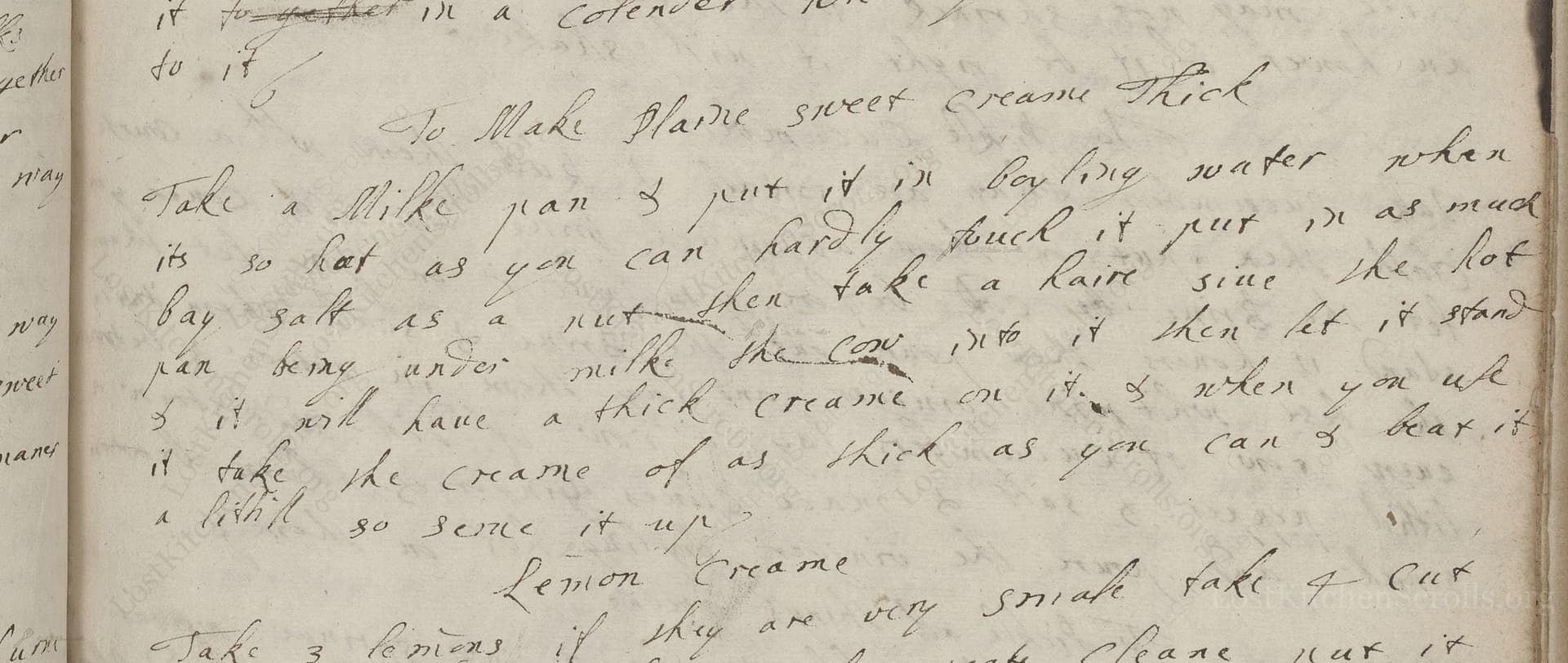
To Make Plaine Sweet Creame Thick
"Take a Milke pan & put it in boyling water when its so hot as you can hardly touch it put in as much bay salt as a nutt then take a Raire siue the hot pan being under milke the combe put in it into it then let it stand & it will have a thick creame on it. & when you use it take the creame of as thick as you can & beat it a litle so serve it up."
Note on the Original Text
The recipe is penned in early modern English, characterized by phonetic spelling and a flowing, unpunctuated style. Terms like 'bay salt' refer to coarse salt once harvested from salt marshes or bays—a prized seasoning. 'Raire siue' is a now-archaic term for a fine sieve. Directions presume hands-on knowledge, with heating measured by touch. The recipe expects its reader to be at home with intuitive methods, and directions are brief yet practical, designed for those already steeped in kitchen routines.

Title
Receipts in cookery and medicine 1700 (1700)
You can also click the book image above to peruse the original tome
Writer
Unknown
Era
1700
Publisher
Unknown
Background
Step into the kitchen of the early 18th century, where this charming culinary manuscript tempts tastebuds with recipes and secrets from a bygone era. A delicious journey for both the curious cook and the history lover.
Kindly made available by
Folger Shakespeare Library
Originating from around 1700, this recipe is drawn from English household manuscripts, representing the simple yet crucial technique of clotted cream making—a staple in British country kitchens. At a time when refrigeration was nonexistent, thickened or 'clotted' creams were a valuable way to preserve the rich top layer of milk, enjoyed spread on bread or served as a luxurious accompaniment to desserts and fruit. The recipe's presence in a commonplace book like 'V.b.273' highlights its domestic importance and the desire to record subtle kitchen know-how for future generations.

Back in the day, the cook would have used a tin or copper milk pan, set within a pot of hot water to carefully control the temperature. A 'raire siue'—an early spelling of 'rare sieve'—refers to a fine mesh, possibly made from horsehair or fine linen, through which the hot milk was filtered or allowed to stand. The process required gentle heat, patience, and attentive hands, all under the watchful eye of a household cook in a scullery or dairy room.
Prep Time
5 mins
Cook Time
15 mins
Servings
4
We've done our best to adapt this historical recipe for modern kitchens, but some details may still need refinement. We warmly welcome feedback from fellow cooks and culinary historians — your insights support the entire community!
Ingredients
- 1 quart whole milk
- 1 teaspoon sea salt (as substitute for bay salt)
Instructions
- To make plain thick sweet cream, first set a saucepan or sturdy pan into a larger pot of simmering water (creating a double boiler effect).
- Pour in about 1 quart of whole milk, and heat it until it's just too hot to comfortably touch—around 140–150°F.
- Dissolve a generous pinch (about 1 teaspoon) of fine bay salt (today, use regular sea salt) into the hot milk.
- Next, place a fine-mesh sieve or cheesecloth over a clean bowl, and milk should be poured over or through it.
- Allow the covered milk to sit undisturbed at room temperature (about 64–68°F) for several hours, or until a thick cream forms on the top.
- Carefully skim the thick cream into a bowl, and whisk gently before serving.
Estimated Calories
130 per serving
Cooking Estimates
Heating the milk and dissolving the salt takes about 15 minutes. Prepping your pan and straining the milk takes another 5 minutes. The cream will naturally thicken as it sits for a few hours at room temperature. This recipe serves about 4 portions, each with roughly 130 calories.
As noted above, we have made our best effort to translate and adapt this historical recipe for modern kitchens, taking into account ingredients nowadays, cooking techniques, measurements, and so on. However, historical recipes often contain assumptions that require interpretation.
We'd love for anyone to help improve these adaptations. Community contributions are highly welcome. If you have suggestions, corrections, or cooking tips based on your experience with this recipe, please share them below.
Join the Discussion
Rate This Recipe
Dietary Preference
Main Ingredients
Occasions

Den Bockfisch In Einer Fleisch Suppen Zu Kochen
This recipe hails from a German manuscript cookbook compiled in 1696, a time whe...

Die Grieß Nudlen Zumachen
This recipe comes from a rather mysterious manuscript cookbook, penned anonymous...

Ein Boudain
This recipe comes from an anonymous German-language manuscript cookbook from 169...

Ein Gesaltzen Citroni
This recipe, dating from 1696, comes from an extensive anonymous German cookbook...
Browse our complete collection of time-honored recipes



